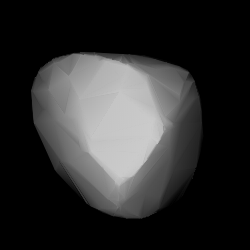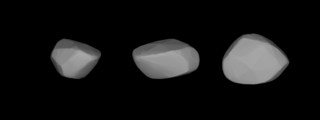
2829 Bobhope is a dark asteroid of the Meliboea family, from the outer region of the asteroid belt. It was discovered on 9 August 1948, by South African astronomer Ernest Leonard Johnson at Union Observatory in Johannesburg. The asteroid was later named after comedian Bob Hope. The asteroid has a rotation period of 6.1 hours and measures approximately 37 kilometers in diameter.
460 Scania is a background asteroid and a slow rotator from the central regions of the asteroid belt. It was discovered by German astronomer Max Wolf at the Heidelberg-Königstuhl State Observatory on 22 October 1900. The uncommon K-type asteroid has an exceptionally long rotation period of 164.1 hours and measures approximately 21 kilometers in diameter. It was named after the Swedish region of Scania, where a meeting was held by the Astronomische Gesellschaft in 1904.
866 Fatme is a large background asteroid, approximately 86 kilometers in diameter, located in the outer region of the asteroid belt. It was discovered by German astronomer Max Wolf at the Heidelberg-Königstuhl State Observatory on 25 February 1917. The X-type asteroid has a short rotation period of 5.8 hours. It was named after "Fatme", a character in the opera Abu Hassan by Carl Maria von Weber (1786–1826).
1575 Winifred, provisional designation 1950 HH, is a stony Phocaea asteroid and slow rotator from the inner regions of the asteroid belt, approximately 9.5 kilometers in diameter.
1031 Arctica, provisional designation 1924 RR, is a dark asteroid from the outer region of the asteroid belt, approximately 75 kilometers in diameter. It was discovered on 6 June 1924, by Soviet−Russian astronomer Sergey Belyavsky at Simeiz Observatory on the Crimean peninsula. It was named for the Arctic Sea.
1074 Beljawskya, provisional designation 1925 BE, is a Themistian asteroid from the outer region of the asteroid belt, approximately 48 kilometers in diameter.
1115 Sabauda is a carbonaceous Meliboean asteroid from the outer region of the asteroid belt, approximately 68 kilometers in diameter. Discovered in 1928 by Italian astronomer Luigi Volta, it was assigned the provisional designation 1928 XC. The asteroid was probably named after the House of Savoy, the former rulers of Italy.

1165 Imprinetta, provisional designation 1930 HM, is a carbonaceous Meliboean asteroid from the outer regions of the asteroid belt, approximately 49 kilometers (30 mi) in diameter. It was discovered on 24 April 1930 by Dutch astronomer Hendrik van Gent at the Union Observatory in Johannesburg, South Africa. The asteroid was named after Imprinetta Gent, wife of the discoverer.
1712 Angola, provisional designation 1935 KC, is a dark asteroid from the outer regions of the asteroid belt, approximately 66 kilometers in diameter. It was discovered on 28 May 1935, by English-born South African astronomer Cyril Jackson at Johannesburg Observatory in South Africa. It is named after the Republic of Angola.
1815 Beethoven, provisional designation 1932 CE1, is a carbonaceous background asteroid from the outer regions of the asteroid belt, approximately 30 kilometers (19 miles) in diameter. It was discovered on 27 January 1932, by German astronomer Karl Reinmuth at the Heidelberg Observatory. The uncommon F-type asteroid seems to have a long rotation period of 54 hours (tentative). It was named after Ludwig van Beethoven.

1241 Dysona, provisional designation 1932 EB1, is a dark background asteroid from the outer regions of the asteroid belt, approximately 77 kilometers in diameter. It was discovered on 4 March 1932, by English astronomer Harry Edwin Wood at the Union Observatory in Johannesburg, South Africa. The asteroid was named after English astronomer Frank Watson Dyson.
1421 Esperanto, provisional designation 1936 FQ, is a dark background asteroid from the outer regions of the asteroid belt, approximately 55 kilometers in diameter. It was discovered on 18 March 1936, by Finnish astronomer Yrjö Väisälä at the Iso-Heikkilä Observatory in Turku, southwest Finland. The presumed C-type asteroid has a rotation period of nearly 22 hours. It was named for the artificial language Esperanto.
1267 Geertruida, provisional designation 1930 HD, is a carbonaceous background asteroid from the inner regions of the asteroid belt, approximately 20 kilometers in diameter. Discovered by astronomer Hendrik van Gent at Johannesburg Observatory in 1930, the asteroid was later named after Geertruid Pels, sister of Dutch astronomer Gerrit Pels.
2140 Kemerovo, provisional designation 1970 PE, is a dark asteroid from the outer region of the asteroid belt, approximately 30 kilometers in diameter.
1384 Kniertje, provisional designation 1934 RX, is a dark Adeonian asteroid from the central regions of the asteroid belt, approximately 26 kilometers in diameter. It was discovered on 9 September 1934, by Dutch astronomer Hendrik van Gent at the Union Observatory in Johannesburg, South Africa. The asteroid was named after a character in the Dutch play Op Hoop van Zegen by Herman Heijermans.

1841 Masaryk (prov. designation: 1971 UO1) is a carbonaceous background asteroid from the outer region of the asteroid belt, approximately 46 kilometers in diameter. It was discovered on 26 October 1971, by Czech astronomer Luboš Kohoutek at Bergedorf Observatory in Hamburg, Germany. The asteroid was named after the first President of Czechoslovakia, Tomáš Garrigue Masaryk.
1680 Per Brahe, provisional designation 1942 CH, is a bright background asteroid from the central region of the asteroid belt, approximately 14 kilometers in diameter. It was discovered on 12 February 1942, by Finnish astronomer Liisi Oterma at Turku Observatory in Southwest Finland. The stony S-type asteroid has a rotation period of 3.4 hours. It is named after Swedish count and governor Per Brahe the Younger.
1405 Sibelius, provisional designation 1936 RE, is a stony Florian asteroid from the inner regions of the asteroid belt, approximately 8 kilometers in diameter. It was discovered on 12 September 1936, by Finnish astronomer Yrjö Väisälä at Turku Observatory in Southwest Finland. The asteroid was named after composer Jean Sibelius.
3345 Tarkovskij, provisional designation 1982 YC1, is a carbonaceous background asteroid from the inner regions of the asteroid belt, approximately 22 kilometers (14 miles) in diameter. It was discovered on 23 December 1982, by Russian astronomer Lyudmila Karachkina at the Crimean Astrophysical Observatory in Nauchnyj, on the Crimean peninsula, and named after filmmaker Andrei Tarkovsky. The C-type asteroid is a slow rotator with a rotation period of 187 hours.
2672 Písek, provisional designation 1979 KC, is a Eunomia asteroid from the central regions of the asteroid belt, approximately 25 kilometers in diameter. It was discovered on 31 May 1979, by Yugoslav astronomer Jaroslav Květoň at the Kleť Observatory in the Czech Republic. The likely elongated asteroid is a suspected tumbler and a slow rotator with an exceptionally long period of 831 hours. It was named after the Czech town of Písek.




